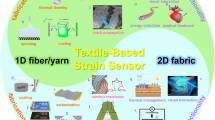Abstract
The mechanical performance of carbon fibre reinforced polymers is predominantly limited by internal stress induced by resin shrinkage of the polymer matrix. Terfenol-D particles are investigated as internal sensors to detect the stress situation on a non-destructive way. Part 1 of the article describes the preparation and characterization of the samples used in the investigation of the sensory effect (Kubicka et al. J Mater Sci 47:5752–5759, 2012). Part 2 presents the results of the evaluation of the stress detection. A fundamental discussion is given how these magnetostrictive particles act as stress sensors in epoxy resins using the Villari effect. Analysing this effect in terms of particle content, particle size and particle distribution the most promising parameters are identified. Obviously the higher the particle content (20 wt%) and the smaller the particle size (<20 μm) combined with a strong homogeneous particle distribution the higher the magnetic flux density changes, in case of tensile loads. These corresponding stress situations are quantified by a Hall probe. Interestingly, the magnetic flux density changes (∆B) can be significantly increased by a pre-magnetization step of the samples, allowing a more sensitive detection of the Villari effect.







Similar content being viewed by others
References
Rudd CD, Long AC, Kendall KN, Mangin CGE (1998) Liquid moulding technologies. Woodhead Publishing Limited, Cambridge
Kruckenberg TK, Paton R (eds) (1998) Resin transfer moulding for aerospace structures. Kluwer Academic Publisher, Dordrecht
Mei W, Okane T, Umeda T (1998) J Appl Phys 84:6208
McKnight GP (2002) Oriented Terfenol-D composites. Dissertation, University of California, Los Angeles (UCLA)
Anjanappa M, Wu Y (1997) Smart Mater Struct 6:393
Krishna Murty AV, Anjanappa M, Wu Y-F (1997) J Sound Vib 206(2):133
Krishnamurthy AV, Anjanappa M, Wang Z, Chen X (1999) J Intell Mater Syst Struct 10:825
Saidha E, Naik GN, Gopalkrishnan S (2003) Struct Health Monit 2:273
Duenas TA, Carman GP (2001) J Appl Phys 90:2433
Dong X, Guan X, Ou J (2009) Effects of particle size on magnetostrictive properties of magnetostrictive composites with low particulate volume fraction. In: SPIE 7289, Nr. 728920, 1
Villari E (1865) Ann Phys Chem 126:87
Lee EW (1955) Rep Prog Phys 18:184
Jiles DC (1995) J Phys D 28:1537
Kubicka M, Mahrholz T, Kühn A, Wierach P, Sinapius M (2012) J Mater Sci 47:5752. doi:10.1007/s10853-012-6466-3
Newnham RE (1986) Ferroelectrics 1:1
Acknowledgements
The authors wish to thank Mr. T. Wawrzik (Institute of Electrical Measurement Science and Fundamental Electrical Engineering, Technical University Braunschweig, Germany) for his assistance in measurements with the Hall probe and its applications.
Author information
Authors and Affiliations
Corresponding author
Rights and permissions
About this article
Cite this article
Kubicka, M., Mahrholz, T., Kühn, A. et al. Magnetostrictive properties of epoxy resins modified with Terfenol-D particles for detection of internal stress in CFRP. Part 2: evaluation of stress detection. J Mater Sci 48, 6578–6584 (2013). https://doi.org/10.1007/s10853-013-7454-y
Received:
Accepted:
Published:
Issue Date:
DOI: https://doi.org/10.1007/s10853-013-7454-y




